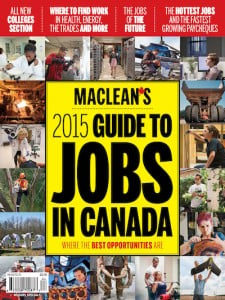Cool Jobs Q&A: Dinosaur maker
Life is a walk in a Jurassic park when you’re a fossil-mounting specialist
Share

 Our 2015 Guide to Jobs in Canada special issue—on newsstands now—takes a look at what employment looks like today, predicts what it will look like in the future, and reveals how to get a foot in the door of some of the hottest industries. As part of our coverage, we’ve profiled a few Canadians who are boldly setting forth on some unusual, fascinating and downright cool jobs.
Our 2015 Guide to Jobs in Canada special issue—on newsstands now—takes a look at what employment looks like today, predicts what it will look like in the future, and reveals how to get a foot in the door of some of the hottest industries. As part of our coverage, we’ve profiled a few Canadians who are boldly setting forth on some unusual, fascinating and downright cool jobs.
GARTH DALLMAN, 53
- Fossil-mounting specialist, Research Casting International
- Average yearly income: $30,000-$40,000+
How did you get into this field?
I was working in museums, using some traditional skills, one being blacksmithing. I lost my job and I saw an article my wife had cut out of the paper about (museum tech services company) RCI. It turned out they required a blacksmith for some fossil mounts.
What education or skills do you have?
I went to college for a museum and parks interpretation diploma and took pottery courses. I was a historical potter for years, so I had some training in terms of aesthetics and colour and form. And I did decorative ironwork: building gates and railings. Learning to reproduce things in clay and steel helped me in being able to reproduce dinosaur bones.
Describe a typical day on the job.
It usually starts with touching base with clients, talking to paleontologists around the world. Once that’s finished, I’m out on the shop floor. Our bread and butter is cast dinosaurs. We have moulds from various specimens housed in museums around the world, and other museums would like to have those. They order one, and then we build that cast skeleton out of fibreglass or polyester resin or polyurethane resin. It’s not just dinosaurs; we also help develop exhibits.
What is your most memorable moment?
We redid the halls at the Royal Ontario Museum. That was pretty exciting. I mounted the juvenile T. rex, Jane. It was one of the first ever found. Even though it wasn’t a huge mount, it was a very significant find.
What are the pros and cons?
The thing that gives me the most satisfaction is working on something and seeing it coming together. You can stand back and appreciate the small steps that go into building a fossil mount. We travel quite extensively around the world, visiting different museums, so that’s always exciting; sometimes too much travel is bad. There’s a lot of pressure with deadlines, that’s the greatest cause of stress here.
Your advice for aspiring fossil mounters?
Stretch some of your abilities, in terms of artistry or sculpting, as well as technical things like welding and working with tools. It’s easier to take a good artist and teach them paleontology than it is to take a paleontologist and try to teach them technical skills.